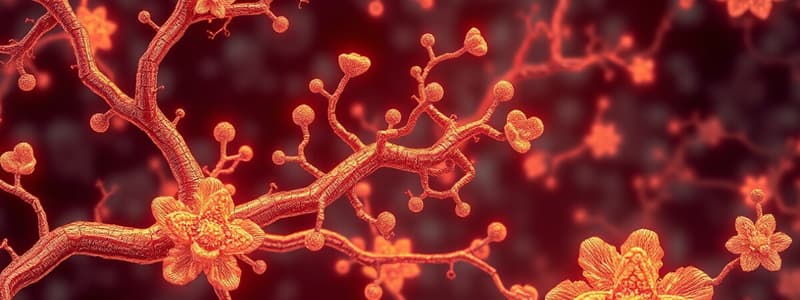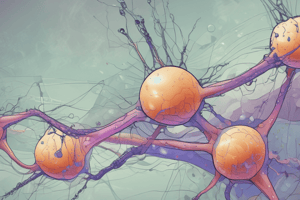Podcast
Questions and Answers
What is the primary effect of GABA receptor activation on neuronal activity?
What is the primary effect of GABA receptor activation on neuronal activity?
- Increases neuronal excitability
- Inhibits neuronal activity (correct)
- Facilitates neurotransmitter release
- Has no effect on neuronal activity
Which drug class is primarily used to enhance GABA effects for treating anxiety?
Which drug class is primarily used to enhance GABA effects for treating anxiety?
- Z-drugs
- Anesthetics
- Benzodiazepines (correct)
- Barbiturates
What distinguishes barbiturates from benzodiazepines in their mechanism of action at GABA receptors?
What distinguishes barbiturates from benzodiazepines in their mechanism of action at GABA receptors?
- Barbiturates increase the frequency of channel opening
- Benzodiazepines act on extra-synaptic receptors
- Benzodiazepines decrease the duration of Cl− channel opening
- Barbiturates prolong the duration of Cl− channel opening (correct)
Which of the following drugs is classified as a negative modulator of GABAA receptors?
Which of the following drugs is classified as a negative modulator of GABAA receptors?
What role do neurosteroids play in the modulation of GABAA receptors?
What role do neurosteroids play in the modulation of GABAA receptors?
Which of the following best describes the action of 5-HT₃ receptors?
Which of the following best describes the action of 5-HT₃ receptors?
What is the primary effect of glycine receptors in the central nervous system?
What is the primary effect of glycine receptors in the central nervous system?
Which of the following anesthetics is known for its rapid onset and short duration of action?
Which of the following anesthetics is known for its rapid onset and short duration of action?
Which of the following is true regarding neurotransmitter modulation by agonists and antagonists?
Which of the following is true regarding neurotransmitter modulation by agonists and antagonists?
What is a common feature of nAChRs and 5-HT₃ receptors?
What is a common feature of nAChRs and 5-HT₃ receptors?
Which statement accurately describes the structure of Cys-loop receptors?
Which statement accurately describes the structure of Cys-loop receptors?
Which of the following best describes the physiological function of nicotinic acetylcholine receptors (nAChRs)?
Which of the following best describes the physiological function of nicotinic acetylcholine receptors (nAChRs)?
What is the role of positive allosteric modulators like gantanamure on nicotinic acetylcholine receptors?
What is the role of positive allosteric modulators like gantanamure on nicotinic acetylcholine receptors?
What underlying issue causes the symptoms observed in myasthenia gravis?
What underlying issue causes the symptoms observed in myasthenia gravis?
Which of the following statements is true regarding the antagonists of nicotinic acetylcholine receptors?
Which of the following statements is true regarding the antagonists of nicotinic acetylcholine receptors?
Flashcards are hidden until you start studying
Study Notes
Cys-loop Receptors
- A class of ligand-gated ion channels, forming pentameric (five subunit) structures.
- Subunits can be homo or hetero-oligomers.
- Each subunit contains a cystine loop formed by a disulfide bond in the N-terminal extracellular domain.
- Each subunit also features four transmembrane domains (TM1-TM4)
- The TM2 domain serves as the lining of the channel pore.
- Ligand binding to the receptor triggers the opening of the gate, allowing ion flow.
Nicotinic Acetylcholine Receptors (nAChRs)
- Permeable to sodium (Na⁺), potassium (K⁺), and calcium (Ca²⁺) ions.
- Classified as non-specific cation channels.
- Play a crucial role in modulating fast synaptic excitation at the neuromuscular junction (NMJ) and within the central nervous system (CNS).
- Gantanamure acts as a positive allosteric modulator, boosting acetylcholine (ACh) levels.
- The α4β2 subtype is known as the "Brown" nAChR.
Agonists:
- Acetylcholine (ACh) acts as a full agonist.
- Varenicline serves as a partial agonist, unable to achieve the maximum effect (Emax).
Antagonists:
- Curare and other neuromuscular blockers inhibit nAChRs at the NMJ, leading to muscle relaxation and paralysis.
- Neostigmine, pyridostigmine, and edrophonium are reversible competitive antagonists for acetylcholinesterase (AChE).
Myasthenia Gravis
- An autoimmune disorder affecting skeletal muscle.
- Characterized by a loss of nAChRs at the neuromuscular junction.
- Symptoms include weakness and fatigue, particularly affecting facial muscles.
- Diagnosis involves blood tests for antibodies against nAChRs.
- The edrophonium test is a diagnostic tool.
- Congenital Myasthenic Syndrome (CMS) involves mutations affecting nAChR expression or defects in nAChR kinetics.
- CMS can occur presynaptically (affecting nAChR) or postsynaptically (affecting AChRs).
5-HT₃ Receptors
- Modulate mood, nausea, and vomiting, contributing to fast synaptic excitation.
- Permeable to sodium (Na⁺) and potassium (K⁺) ions, classifying them as non-specific cation channels.
- Their structure is identical to nAChRs.
- They are expressed in the gut, where they modulate peristalsis.
- Alosetrion is a medication used to treat irritable bowel syndrome (IBS).
GABA Receptor
- Inhibits neuronal activity.
- Functions as an anion channel.
- Muscimol acts as an agonist.
- Positive allosteric modulators include benzodiazepines (treat anxiety and have sedative effects), barbiturates, and other medications.
Serotonin (5-HT) Receptors
Agonists:
- Serotonin (5-HT) itself acts as a direct agonist.
Antagonists:
- Anti-emetic drugs, such as ondansetron (drugs ending in "senton") and partial agonists like tropisetron, act as antagonists.
Glycine Receptor
- Inhibits neuronal activity in the spinal cord and brain stem.
Agonists:
- Glycine and taurine are direct agonists.
Antagonists:
- Strychnine is an antagonist.
Anesthetics
- Examples include parenteral anesthetics like thiopental, midazolam, propofol, and etomidate.
- They exhibit rapid onset and short duration of action.
- They can either stimulate or increase the sensitivity of GABAA receptors.
GABAA Receptors
- Inhibit neuronal activity.
- Function as anion channels, permeable to chloride ions (Cl⁻).
- Agonists mimic the effects of GABA.
Positive Allosteric Modulators:
- Benzodiazepines enhance the effects of GABA:
- Examples include diazepam, lorazepam, and midazolam.
- They are available in long and short half-life formulations.
- Benzodiazepines are used to treat epilepsy and anxiety.
- At high doses, benzodiazepines exhibit sedative effects.
- Barbiturates increase the duration of Cl⁻ channel opening.
- Thiopental is a short-acting barbiturate.
Cα, B, and Y Subunits
- Their presence increases the frequency of channel opening, leading to increased Cl⁻ influx into the postsynaptic cell.
Anesthetics (GABAA Receptor Modulation)
- Propofol binds to the α1β3γ2 GABAA receptor, which is the primary synaptic GABAA receptor.
- Etomidate is another anesthetic that interacts with GABAA receptors.
- Key anesthetic agents function as positive allosteric modulators of GABAA receptors.
Z-drugs (# GABAA Receptor Modulation)
- Zolpidem, zopiclone, and zaleplon are non-benzodiazepine hypnotics used to treat insomnia.
- They act as positive allosteric modulators of GABAA receptors.
Neurosteroids (# GABAA Receptor Modulation)
- Neurosteroids also function as positive allosteric modulators of GABAA receptors, acting at low concentrations.
- Their levels can be altered by alcohol and selective serotonin reuptake inhibitors (SSRIs).
Pregnane Steroids (# GABAA Receptor Modulation)
- Pregnane steroids are neurosteroids that act as positive allosteric modulators of GABAA receptors.
- Their levels are influenced by alcohol and SSRIs.
Phase Conductance (# GABAA Receptor Modulation)
- It is mediated by post-synaptic receptors activated by the synaptic release of GABA.
Tonic Conductance (# GABAA Receptor Modulation)
- It is mediated by extra-synaptic receptors.
- It is not sensitive to neurosteroids.
Studying That Suits You
Use AI to generate personalized quizzes and flashcards to suit your learning preferences.




